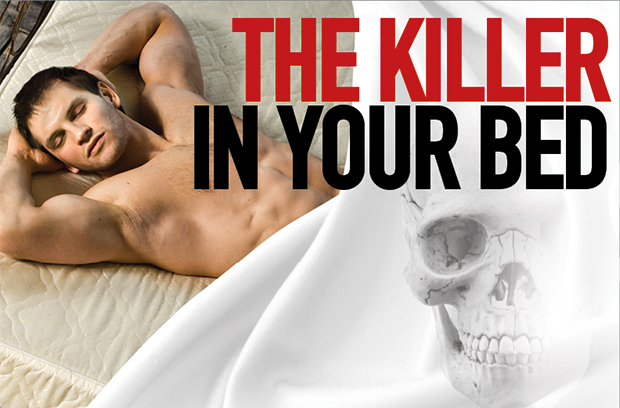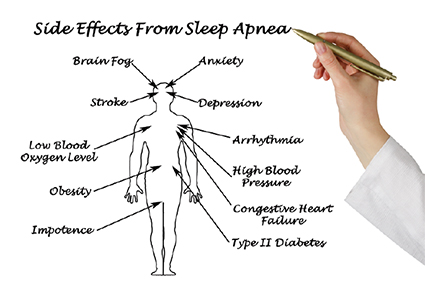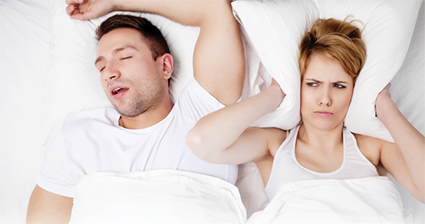Sleep Apnea Can Kill You

BIG NECK? BIG PROBLEM!
Just about every guy dreams of getting big through bodybuilding, but that puts you at greater risk for a silent nighttime killer: obstructive sleep apnea. Here’s the article that might not just renew your life but literally save it.
Ever wonder why the world’s strongest men—guys who lift tons of pounds every day as part of incredibly demanding workouts—succumb to fatal heart attacks at night when they’re completely at rest?
Take guys such as 13-time Pro Bowl NFL defensive lineman Reggie White, who passed away at age 43 in 2004, or strongman Mike Jenkins, winner of the 2012 Arnold Strongman, who topped the scales at almost 400 pounds and was even photographed pulling a fire truck, but didn’t live to see his 32nd birthday.
Some folks may point to the use of anabolic substances as a contributing factor, and that may be at least partially right. The real culprit, however, is more likely obstructive sleep apnea (OSA), a hidden condition that occurs only when you’ve fallen asleep. Soft tissues of the throat begin to relax at night and ultimately encroach on the diameter of the windpipe and block it (which occurs more often when you sleep on your back). In fact, the vibrations of those tissues is what causes horrendous snoring, but OSA isn’t simply bad snoring but, rather, when you stop breathing altogether. The word apneais Greek for “without breath,” as in, when you stop breathing.
Whether you’ve got a thick, muscular neck or are obese seemingly does notmatter, which is why OSA is massively underreported but strikingly common among bodybuilders, strongmen, NFL linemen, and other strength and power athletes.1And with the size of men (and even women)—whether trained athletes or because of obesity—pushing human limits, the condition continues its stealth attack, which may affect as much as 20 percent of the North American population. Half of those have no idea they’re even affected.2
Silent Killer

There’s practically no research linking large athletes with OSA, but that doesn’t mean there’s a lack of evidence. Today, most professional strongmen and power athletes are aware of the condition and potential treatments. But because of the perceived embarrassment of the problem, many others are not, especially among amateur competitors and recreational athletes.
A recreational bodybuilder of more than 25 years, I was diagnosed with a mild condition a decade ago at a sleep clinic. Here’s what was happening: I’d stop breathing for 20, 30, 40, 50, 60 seconds or yes, even longer—that is, until my brain sensed mortal danger and finally signaled a gasp for breath. A mild condition is five to 15 such events each hour, all night long, while in severe cases, these breathless events can happen 30 or more times eachhour.3
Because you’re groggy and not fully awake, you may not even recognize the problem, but a sleeping partner may well. You’ll neverget a restful night’s sleep, and that can continue for years.
Such fragmented sleep leads to daytime sleepiness and chronic fatigue, further signs of your affliction. Not surprisingly, it’s easy to doze off at work, in your car, at meetings … in fact, you live in a constant state of being tired. You’re five times more likely to be involved in a car accident or suffer other medical problems, including being three times more likely to have a stroke.4With so little oxygen in the blood, the heart has to work harder and blood pressure rises, leading to a chronic condition. Your risk of having a stroke or sudden cardiac arrest soars;5in fact, in severe cases, it can trigger a heart attack in the middle of the night.
All the while, you have no idea you have the condition as you simply become accustomed to feeling tired all the time. Likely, you’ll rely on pre-workouts to get you through your workouts.
The health risks are real, and they become more pronounced in the off-season when you gain weight and as you grow older. Of course, it’s also counterproductive to your training efforts because anabolic hormones are blunted. Given that rest is a key component of recovery, you’ll never optimize conditions for muscle growth.
Testing for Troubles

Researchers from the University of Toronto created a test called STOP-BANG, and I strongly urge you to visit their website (Stopbang.ca, not .com) to assess your personal risk. It includes measurements of your body mass index, age, gender, neck size, blood pressure, snoring, and other factors. Individuals with a neck size of 17 or larger are particularly highly correlated with OSA.6Don’t think for a minute that because your neck is all muscle, you’re in the clear.
You can actually test for the condition at a sleep clinic where you’re observed and measured by technicians as you sleep, or by using a take-home sleep monitor. Tests measure respiration, when and how often you stop breathing, blood oxygen and carbon dioxide levels, your heart rhythm, and brainwave activity. Most insurance plans cover the tests.
If you report a mild to severe case, a few options are available, depending on the degree of severity. Very mild cases may easily be treated by rinsing your sinuses each night, using a nasal decongestant, sleeping on your side, or eliminating alcohol before going to bed. Clearly, losing weight can be a big plus.
A more severe case requires more serious intervention. Therapies may include inserting a custom-made mouthpiece that pulls your lower jaw forward to keep the airway open, surgery to remove tissue in the back of your mouth, and using an assisted breathing machine with continuous positive airway pressure (CPAP), probably the most common treatment. A small compressor acting like a splint blows air into a mask worn during sleep that prevents your airway from collapsing. This not only prevents the apnea but also stops snoring.
I’ve seen many products sold on TV and online that claim to treat OSA but are completely ineffective because they don’t address the underlying problem: the closing of the airway. Don’t get snookered.
Stick with It

Speaking from experience, it’s difficult to get used to the units at first. They’re decidedly unsexy and unwieldy, and may leave your mouth dry. No wonder the compliance rate for using units has been measured and it’s not good news (from 29 to 83 percent, depending on the study), and many folks never even use their units, not even once.7,8That’s why insurance companies are now requiring proof of use—many units now come with computer chips—before covering the machine’s costs. What’s been shown is that if you don’t start using the machine the first week, you never will.
Once you become accustomed to the unit, trust me, the changes in your life will be striking. You’ll feel well rested in the morning, won’t be subjected to extreme sleepiness during the day, will have more energy for your workouts, and most likely will realize greater gains.
One amateur Canadian bodybuilder from Mississauga, Carl Cheung, told me the CPAP machine has changed his life. He reports improvements in the quality of life in several ways: no more extreme fatigue, better mental focus, faster reaction times, less need for sleep because it’s of better quality, lower blood pressure, greater ease of making gains and losing body fat, better mood, and better sex.
Cheung’s outcomes aren’t just anecdotal; research shows that individuals who stick with CPAP treatment show a reduction in apnea and consistently feel better, and encounter fewer complications of the disease.9
The evolution of man hasn’t kept pace with the recent super-sizing of physiques that’s due in part to advanced training and nutrition protocols. Inevitably, some systems of the body—the weak links, if you will—begin to show up. They’re a reminder of man’s physical upper limits. If you take efforts to put on size seriously, at least be aware of what can be happening that you can’t see. It doesn’t happen like an on/off switch; the changes taking place are very gradual.
Editor's Note: If you're interested in learning more about ways to boost performance and fight the aging process through science, check out this article.
REFERENCES
- George CF, Kab V, Kab P, Villa JJ, Levy AM. Sleep and breathing in professional football players. Sleep Med. 2003 Jul;4(4):317-25.
- Medline Plus/ScoutNews. Portable Monitors OK for Spotting Sleep Apnea: New Guidelines, August 2014. http://m.medlineplus.gov/news/fullstory_147684.htm. Accessed July 9, 2018.
- Sleep Apnea. American Academy of Family Physicians, May 2014.
- Statistics & Research. http://www.midwestapnea.com/statistics—research.html. 2014 Sept 3.
- Rowley JA, McGowen C, Lareau S, Fahy B, Garvey C, Sockrider M. What Is Obstructive Sleep Apnea in Adults, Patient Information Series, American Thoracic Society, 2009.
- Schmidt-Nowara Wolfgang. Patient Information: Sleep Apnea In Adults (Beyond The Basics), Wolters Kluwer (UpToDate.com), July 2014.
- Weaver TE, Kribbs NB, Pack AI, et al. Night-to-night variability in CPAP use over the first three months of treatment. Sleep. 1997 Apr;20(4):278-83.
- Weaver TE, Grunstein RR. Adherence to continuous positive airway pressure therapy: the challenge to effective treatment. Proc Am Thorac Soc. 2008 Feb 15;5(2):173-8.
- National Heart, Lung, and Blood Institute. What Is Sleep Apnea? http://www.nhlbi.nih.gov/health/health-topics/topics/sleepapnea/livingwi... Sept 3.

